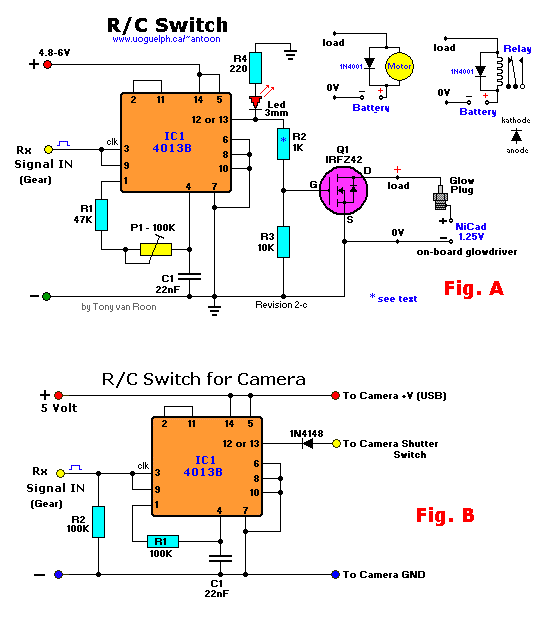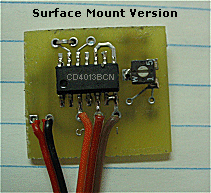
Parts List:
All resistors 1/4w/5% tolerance, unless otherwise posted.
R1 = 47K IC1 = MC14013B
R2 = 1K Q1 = BUZ11, IRFZ42, NTE2395, or ECG2395
R3 = 10K S1 = on/off switch (optional)
P1 = 100K Servo lead
C1 = 22nF
Parts only KIT available, Click here: R/C Switch
Description:
The circuit, as described above, is a so-called "Radio Controlled Electronic Switch". It can be used to switch on/off
anything electrical, whatever it is. Here are a couple of examples: navigation lights, landing gear, sound systems,
glowplug driver, bomb release, parachute, search lights, gyros, and so on.
Fig. A shows the regular setup for common accesories such as motors, glowplugs, bomb-doors, relays, etc. If you like
to hook it up to a camera, see Fig. B. Note that for the Camera Shutter version the value for R1 and R2 is
different (100K). Please note that this system will not work with PCM.
Hart of the circuit is a CMOS Dual 'D' Flip-Flop MC14013B. The input Flip-Flop is
designed as a monostable pulse generator by means of R1, P1 and C1 connected between 'Q' and the RESET input,
which produces a preset pulse-length set by the adjustable potmeter and starts at the rising edge of the input
pulse. When this monostable times out it's inverted 'Q' signal goes high and clocks the output stage of the
Flip-Flop, which is used as a normal type 'D', to sample the input pulse. If the duration of the input pulse is
longer than the preset monostable pulse, then a logic high level will be clocked to the output of the 'D' type.
A shorter input pulse will cause a logic low to be clocked to the output. In short, both halves of the IC perform
two different logic funtions.
The output drives the output device which in this circuit is the IRFZ42 TMOS FET. It needs only
2-volt on it's gate to fully turn-on and has an rDS-ON resistance of only 0.028 ohm. To invert the operation of the
r/c switch, you can connect R2 either to pin 12 or 13 of the MC14013B. This circuit is easy in design and to built
and can easily be done using vector board, vero-board, or whatever. My unit measures 5/8" by 1-1/4" but I know I can
do a lot smaller by choosing smd components, probably 3/8" x 1/2". You can use a case or heat-shrink; I used the
latter. This unit is NOT ment as a motor-switch for electric flight. For that
purpose check out the "R/C Electric Motor Switch".
Adjusting the switch: To test the unit hookup a light and a battery,
making sure the + of the battery goes to the Drain of Q1. Adjust the potmeter P1 to somewhere in the middle and set
the transmitter function of your choice (say the throttle) to the point where you wish to switch the unit. Now
adjust the potmeter P1 to the point the light comes on. If it does, your unit functions properly and you can play
with whatever other setup you have in mind. If you intend to use this unit as a on-board glowdriver, make sure to
use havy wiring between glowplug, battery and r/s switch. A 'Y'-lead to the throttle servo is required. If you use
this unit to switch relays or a small dc-motor, then a 'spark eliminator' diode (1N4001) is required. Cathode of the
diode goes to the '+' side of the battery. (See diagram).
 At the left you see the Surface Mount version (SMT),
measuring 15mm x 17mm!
At the left you see the Surface Mount version (SMT),
measuring 15mm x 17mm!
Final Word:
The IRFZ42 is a TMOS Power FET. They can be pricy ($12 Can). Other substitutes like the IRFZ44 will work too.
Watch for static discharge with this one!
IC1, the MC14013B, is a CMOS SSI type Dual Flip-Flop. It features a direct pin-for-pin
replacement with the CD4013B, NTE4013B, ECG4013B, and others.
The output signal can be inverted by selecting either pin 12 or 13. To make life easier, you could install a
miniature on-on switch. The middle contact going to R2, and pin-12 & 13 to the other two
contacts.
Original author of the circuit diagram is Ken Hewitt. I modified it somewhat because we can't get the BUK555-60B
(Q1). Ken also has a way to put the circuit on a strip-solder board. Check it out! Please visit Ken's website at:
Ken Hewitts Electronic Projects
Back to Gadgets Menu page
Copyright © 1998, Tony van Roon


 At the left you see the Surface Mount version (SMT),
measuring 15mm x 17mm!
At the left you see the Surface Mount version (SMT),
measuring 15mm x 17mm!